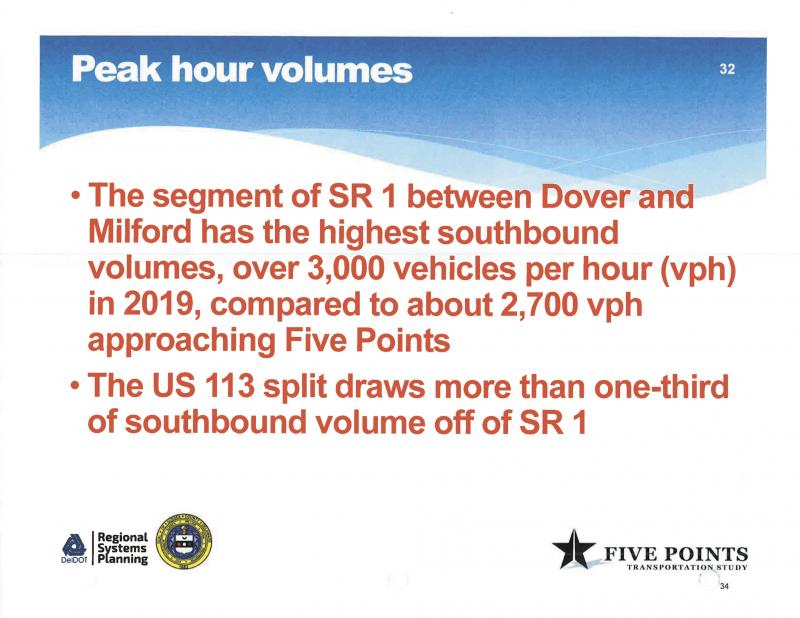DelDOT presents data to back up Route 16 contention
It’s possible to drive from Maine to Five Points and encounter only one stoplight. The most significant highways in that statement are I-95 and Delaware Route 1; the only signaled intersection in that continuous pathway before Five Points is the one at Route 1 and Route 16.
At the Oct. 28 meeting of the Five Points Working Group, DelDOT engineers spent most of the two-hour session talking about plans underway to remove that last obstruction to the free flow of traffic. Mark Luszcz brought out the Maine to Five Points factoid in his discussion.
At a number of meetings over the past year and a half, working group members have questioned the wisdom of replacing that last signaled crossover with a grade-separated interchange before removal of crossovers and associated improvements downstream between Minos Conaway Road and Five Points. The concern is that without that signal interrupting southbound traffic, there will never be any gaps allowing local traffic at the Cave Neck Road intersection and the Minos Conaway to Five Points intersections to cross Route 1.
Despite previous assessments in 2016 showing the Route 16 project wouldn’t cause problems downstream, DelDOT agreed to do further studies in 2019 to reaffirm its conclusions.
That’s not to say DelDOT doesn’t recognize there are crossing problems in the Minos Conaway Road and Route 1 area. In a nutshell, they said all acceptable traffic gaps created by the light at Route 16 on the heaviest traffic days of summer disappear by the time traffic flow reaches the Nassau Bridge. From Cave Neck Road south, local traffic fills the gaps, so they are effectively gone by the time the flow reaches the bridge.
Luszcz said engineers studied 158 hours of video footage from peak weekends this past summer. At Monday’s meeting, he showed charts and graphs, and portions of the video to show methodology and statistics. Here’s some of what was determined:
- Because of other interchange work north of Milford, there were three fewer signals in 2019 between Dover and Milford compared to previous years. Although there was a slight increase in traffic in 2019, the elimination of those signals – based on travel time data – did not create what engineers termed a “carmageddon” at either 16 or Five Points.
- Using data from Saturday, Aug. 17, in the peak of the summer season, the study determined that the greatest flow of traffic on Route 1 is between Dover and Milford. The peak travel times on that Saturday were between 9 and 11 a.m., with more than 3,000 vehicles per hour passing Frederica.
- The US 113 split north of Milford removes over one-third of southbound traffic. On that Saturday, the split reduced the Route 1 traffic from over 3,000 vehicles per hour to about 1,865 vehicles per hour. With infilling from intersections south of Milford including Cave Neck and Minos Conaway roads, the traffic count had increased to 2,265 vehicles per hour just north of Nassau Bridge. Acceptable gaps for crossing traffic are considered to be eight seconds or longer. While the Route 16 light created 12 acceptable gaps in that peak traffic just south of the intersection, that number was down to five by the time traffic reached Cave Neck Road and was down to only one gap by the time it reached Nassau.
- During the 158 hours of video review, there were no standing queues of traffic north of Nassau on either July 4 or Aug. 17.
- The highest hourly volume day on Route 1, between 9 and 10 a.m., came on July 27 when just under 2,500 vehicles passed Eagle Crest north of Cave Neck Road.
Luszcz noted that the routes 1 and 16 intersection accounts for the most annual crashes of any single intersection in the Five Points study area. “Removing all the traffic signals to the north didn’t make traffic worse,” said Luszcz. “Delaying the Route 16 project would only delay safety improvements there and wouldn’t make the Minos Conaway improvements happen any faster.”
That’s why DelDOT is sticking to its guns on proceeding with its plans to construct the Route 16 grade separation before the Minos Conaway-area improvements.
Planning, design and right-of-way acquisition are underway for both projects. All of that takes time. If the rest of the process proceeds as planned, both projects – totaling more than $50 million in costs – should be complete and providing relief by 2025.
In the meantime, drivers will have to be patient, especially during the peak weekend hours of summer. Popularity has its price.

















































